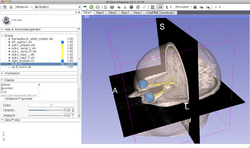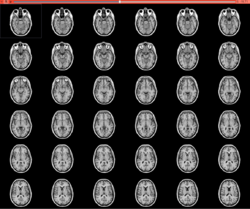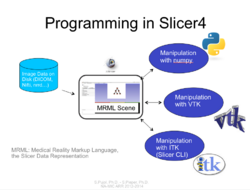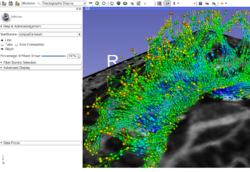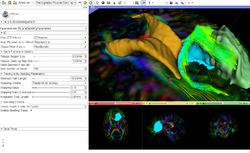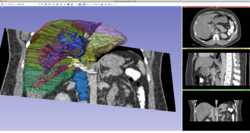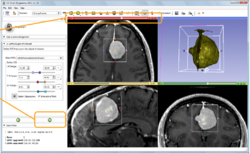Home < 4.0 < Training
Introduction: Slicer 4.0 Tutorials
- This page contains "How to" tutorials with matched sample data sets. They demonstrate how to use the 3D Slicer environment (version 4.0 release) to accomplish certain tasks.
- For tutorials for other versions of Slicer, please visit the Slicer training portal.
- For "reference manual" style documentation, please visit the Slicer 4.0 documentation page
- For questions related to the Slicer4 Compendium, please send an e-mail to Sonia Pujol, Ph.D
For information on 3D Slicer version 3.6, see the 3.6 Training Pages.
General Introduction
Slicer Welcome Tutorial
- The SlicerWelcome tutorial is an introduction to Slicer based on the Welcome module.
- Author: Sonia Pujol, Ph.D.
- Audience: First time users who want a general introduction to the software.
|
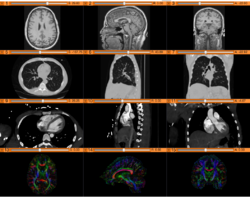
|
Slicer4Minute Tutorial
- The Slicer4Minute tutorial is a brief introduction to the advanced 3D visualization capabilities of Slicer4.0.
- Author: Sonia Pujol, Ph.D.
- Audience: First time users who want to discover Slicer in 4 minutes.
- The Slicer4Minute dataset contains an MR scan of the brain and 3D reconstructions of the anatomy
|
|
Slicer4 Data Loading and 3D Visualization
Tutorials for software developers
Slicer4 Programming Tutorial
Specific functions
Slicer4 Diffusion Tensor Imaging Tutorial
- The Diffusion Tensor Imaging Tutorial course guides through the basics of loading Diffusion Weighted images in Slicer, estimating tensors and generating fiber tracts.
- Author: Sonia Pujol, Ph.D.
- Audience: End-users and developers
- The DTI dataset contains an MR Diffusion Weighted Imaging scan of the brain.
|
|
Slicer4 Neurosurgical Planning Tutorial
Slicer4 3D Visualization of DICOM images for Radiology Applications
- The Slicer4RSNA course guides through 3D data loading and visualization of DICOM images for Radiology Applications in Slicer4.
- Author: Sonia Pujol, Ph.D., Kitt Shaffer, M.D., Ph.D.
- Audience: Radiologists and users of Slicer who need a more comprehensive overview over Slicer4 visualization capabilities.
- The Slicer4RSNAdataset1 and Slicer4RSNAdataset2 contain a series of MR and CT scans, and 3D models of the brain, lung and liver.
|
|
Slicer4 Quantitative Imaging tutorial
- The Slicer4 Quantitative Imaging tutorial guides through the use for Slicer for quantifying small volumetric changes in slow-growing tumors, and for calculating Standardized Uptake Value (SUV) from PET/CT data.
- Authors: Jeffrey Yap, Ph.D., Ron Kikinis, M.D., Randy Gollub, M.D., Ph.D., Wendy Plesniak, Ph.D., Nicole Aucoin, B.Sc., Sonia Pujol, Ph.D., Valerie Humblet, Ph.D., Andriy Fedorov, Ph.D., Kilian Pohl, Ph.D., Ender Konugolu, Ph.D.
- Audience: Radiologists and users of Slicer who need a more comprehensive overview over Slicer4 quantitative imaging capabilities.
- The PETCTFusion and Change Tracker datasets contain a series of MR, CT and PET data.
|
|
Additional resources
- This Intro to Slicer4.0 webinar provides an introduction to 3DSlicer, and demonstrates core functionalities such as loading, visualizing and saving data. Basic processing tools, including manual registration, manual segmentation and tractography tools are also highlighted. This webinar is a general overview. For in depth information see the modules above and the documentation pages.
- Authors: Julien Finet, M.S., Steve Pieper, Ph.D., Jean-Christophe Fillion-Robin, M.S.
- Audience: First time users interested in a broad overview of Slicer’s features and tools.
|
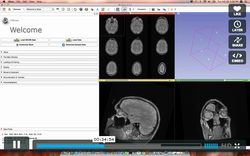
|

